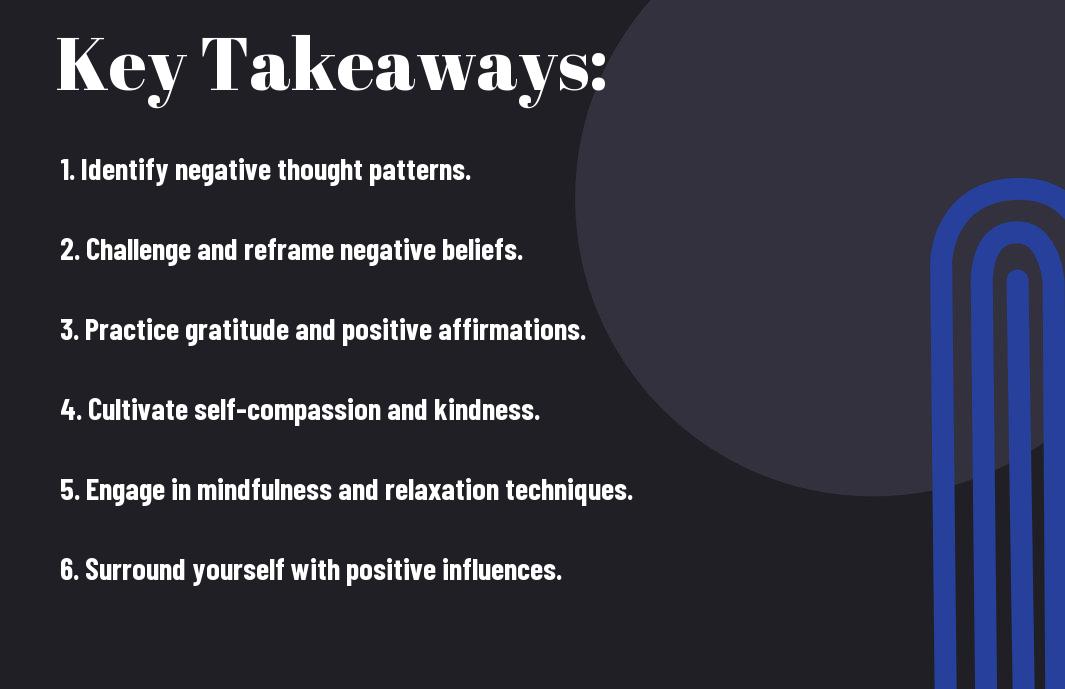Overcoming negative thought patterns is a crucial step towards improving mental well-being and enhancing overall quality of life. Negative thought patterns can impact our emotions, behaviors, and relationships, leading to stress, anxiety, and depression. By rewiring our brains for positivity, we can break free from the cycle of negative thinking and create a more positive outlook on life. This blog post will explore effective strategies and techniques to help you overcome negative thought patterns and cultivate a more positive mindset.
Key Takeaways:
- Awareness is the first step: Recognize and observe your negative thought patterns before you can change them.
- Challenge negative beliefs: Question the validity and accuracy of your negative thoughts to shift them to more positive ones.
- Practice gratitude and positivity: Cultivate a habit of focusing on the good things in your life to rewire your brain for positivity.
- Replace negative self-talk: Replace self-criticism with self-compassion and positive affirmations to boost your self-esteem.
- Seek support when needed: Don’t hesitate to reach out to friends, family, or a professional if negative thought patterns become overwhelming or persistent.

Identifying Negative Thought Patterns
If you want to overcome negative thought patterns and rewire your brain for positivity, the first step is to identify the negative thought patterns that are holding you back. By becoming aware of these patterns, you can begin to challenge and change them, paving the way for a more positive mindset.
Recognizing Pervasive Negativity
Thought patterns that are constantly negative can have a profound impact on your mental well-being. Recognizing these pervasive negative thoughts is crucial in order to break free from their grip. Common signs of pervasive negativity include constant self-criticism, expecting the worst in every situation, and dwelling on past mistakes.
It’s important to acknowledge that these negative thought patterns are not serving you and are only hindering your personal growth and happiness. By recognizing the pervasive nature of these thoughts, you can begin to challenge them and replace them with more positive and empowering beliefs.
Common Triggers and Situations
Pervasive negative thought patterns are often triggered by specific situations or events. Identifying these common triggers can help you anticipate when negative thoughts are likely to arise, allowing you to respond more effectively. Situations such as receiving criticism, facing a challenging task, or being in a high-pressure environment can all trigger negative thought patterns.
Any situation that threatens your sense of security, self-worth, or control has the potential to trigger negative thoughts. By being aware of these triggers, you can start to develop strategies to cope with them in a healthier and more positive way.
Strategies for Overcoming Negativity
Despite the challenges that negative thought patterns present, there are strategies you can implement to rewire your brain for positivity. By actively engaging in these strategies, you can bring about significant changes in your mindset and overall well-being.
Mindfulness and Awareness Techniques
Strategies centered around mindfulness and awareness are powerful tools for overcoming negativity. By practicing mindfulness, you can learn to observe your thoughts and emotions without judgment, allowing you to detach from negative patterns. Techniques such as meditation, deep breathing exercises, and body scans can help you cultivate a greater sense of self-awareness and presence in the moment.
Approaches Cognitive Behavioral Approaches
Cognitive Behavioral Approaches
Approaches Cognitive Behavioral Approaches involve identifying negative thought patterns and replacing them with more positive and realistic ones. By challenging irrational beliefs and restructuring your thinking, you can break free from the cycle of negativity. This approach often involves working with a therapist or using self-help resources to develop coping strategies and new ways of thinking.
Building a Positive Mindset
Unlike letting negative thoughts take control, building a positive mindset is a deliberate and empowering process. It involves reshaping the way you perceive the world and yourself. By focusing on the positive aspects of life, you can rewire your brain to default to optimism and resilience. If you find yourself questioning ‘How can I rewire my negative thoughts into positive ones?’, harnessing the power of positive thinking and gratitude can be a game-changer. For more insights, you can also check out How can I rewire my negative thoughts into positive ones?
Cultivating Gratitude and Positive Thinking
Cultivating gratitude involves consciously appreciating the good things in your life, no matter how small. Start a gratitude journal where you write down things you’re grateful for each day. This practice shifts your focus towards positivity and trains your brain to notice the silver linings in any situation. Additionally, practicing positive thinking involves reframing negative thoughts into more optimistic ones. Instead of dwelling on what could go wrong, focus on what could go right.
Establishing Healthy Habits and Routines
For establishing healthy habits and routines, begin by incorporating activities that promote mental and physical well-being into your daily life. This can include regular exercise, healthy eating, quality sleep, and mindfulness practices. Consistency is key in forming these habits, as they contribute to a positive mindset and overall sense of well-being.
Healthy habits create a strong foundation for a positive mindset. When your body is nourished and your mind is at ease, it becomes easier to fend off negative thoughts and embrace a more optimistic outlook. By prioritizing self-care and healthy routines, you are setting yourself up for success in rewiring your brain for positivity.
Sustaining Positivity
Not every day will be easy, but sustaining positivity is essential for long-term mental well-being. It requires conscious effort and dedication to override ingrained negative thought patterns and cultivate a positive mindset.
Creating a Support Network
An essential aspect of sustaining positivity is creating a support network. Surrounding yourself with positive, encouraging individuals can significantly impact your ability to maintain a healthy outlook. These individuals can offer guidance, support, and reassurance during challenging times. Whether it’s friends, family, or mental health professionals, having a support system in place can help you navigate through moments of doubt and negativity.
Continuous Practice and Reassessment
Positivity is not a destination but a journey. Continuous practice of positive thinking is crucial to rewiring your brain for lasting change. It involves regularly challenging negative thoughts, replacing them with affirming beliefs, and consistently practicing gratitude and mindfulness. Additionally, reassessment of your progress is vital to identify areas that may need additional attention or improvement.
To sustain positivity over time, it is essential to incorporate these practices into your daily routine. Celebrate your victories, no matter how small, and acknowledge when you slip back into negative thought patterns. By committing to continuous practice and reassessment, you can strengthen your resilience and cultivate a more positive outlook on life.
FAQ
Q: What are negative thought patterns?
A: Negative thought patterns are recurring thoughts that are pessimistic, self-critical, or fear-based, which can lead to feelings of anxiety, depression, or low self-esteem.
Q: How do negative thought patterns affect our mental health?
A: Negative thought patterns can contribute to stress, anxiety, and depression, impacting our mental health and overall well-being.
Q: What are some common examples of negative thought patterns?
A: Common examples include catastrophizing (expecting the worst), black-and-white thinking (seeing only extremes), and mind reading (assuming what others think).
Q: How can we overcome negative thought patterns?
A: To overcome negative thought patterns, we can practice mindfulness, challenge our negative thoughts, reframe perspectives, and cultivate self-compassion and gratitude.
Q: How does rewiring our brain for positivity help?
A: By rewiring our brain for positivity through techniques like cognitive-behavioral therapy, positive affirmations, and gratitude practices, we can create new neural pathways that promote a more optimistic outlook and improve our mental health.
Learn more:








